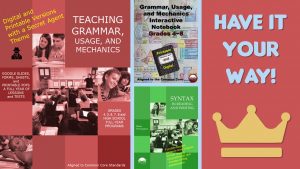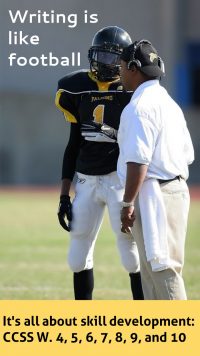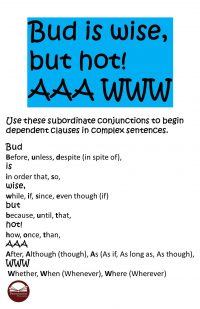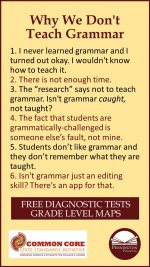Free Grammar, Usage, and Mechanics Resources

Pennington Publishing Grammar Programs
How do most teachers teach grammar and mechanics? Frankly, many of us just are not teaching these subjects, except as a few weeks of drill and kill worksheets prior to the standardized test. Teachers either perceive grammar and mechanics instruction as too boring or as too difficult to teach, so they avoid it like the plague. Some teachers may rationalize why they don’t teach these subjects. You’ve heard the comments: “I didn’t learn grammar and mechanics, and I turned out all right” or “I teach grammar and mechanics through the writing process” or “The students should already know these skills—these are not my grade level standards” or “I once that grammar is acquired naturally through oral language development.”
Well-meaning teachers borrowed a well-used copy of Daily Oral Language activities from another teacher years ago and have faithfully used the same lessons as “openers” ever since. The advantage of such “programs” is that they require no teacher preparation. Unfortunately, these collections of grammar and mechanics mistakes provide no diagnostic information, have few teaching resources, and fail to establish a sensible instructional scope and sequence. Students simply rehearse errors. This ineffective practice rarely translates to mastery learning. Learning grammar and mechanics out of the context of meaningful writing may help students get a few questions correct on the standardized test, but this knowledge just won’t transfer to their writing.
As a middle and high school ELA teacher, I’ve always favored a balanced approach to teaching grammar, usage, and mechanics in the context of reading, writing, listening, and speaking. Like many veteran teachers I’ve found that openers, daily edits, and mini-lesson approaches rarely produced student retention and simply did not show up in student writing and speaking. With the advent of the Common Core State Standards, I welcomed the death knell of these approaches and found the specifics of the grade-level Language Standards, coupled with the Progressive Skills Review, a more realistic and productive approach to instruction. I’ve always believed in the dual role of teachers to help students keep up with rigorous grade-level instruction, while they catch up with content and skill deficits through individualized assessment-based instruction.
Teachers do favor different instructional approaches, and a variety of methods are certainly useful. I’ve written and taught the grades 4–high school Teaching Grammar and Mechanics with interactive lectures, practice and error analysis, simple sentence diagrams, mentor texts with writing applications, formative assessments, and bi-weekly unit tests. I’ve also found value in the interactive notebook approach, authoring and piloting the grades 4–8 Teaching Grammar and Mechanics Interactive Notebooks. Additionally, I so appreciate the contribution of linguists, such as the late William Van Cleve, who advocated a “third camp” to focus on a sentence-level function approach. My Syntax in Reading and Writing reflects this practical approach.
Having recently reviewed the following articles (over 60 at last count) and their accompanying FREE resources and lessons, I’m excited to share with you a teacher’s experience, opinions, research, and trial and error discoveries of what works to help students learn the fundamentals of our English language.
Grammar, Usage, and Mechanics
How to Eliminate “To-Be” Verbs in Writing
https://blog.penningtonpublishing.com/grammar_mechanics/how-to-eliminate-to-be-verbs-in-writing/
Every English teacher has a sure-fire revision tip that makes developing writers dig down deep and revise initial drafts. One of my favorites involves eliminating the “to-be-verbs”: is, am, are, was, were, be, being, and been. Learn the four strategies to revise these “writing crutches.”
Why Daily Oral Language (D.O.L.) Doesn’t Work
https://blog.penningtonpublishing.com/grammar_mechanics/why-daily-oral-language-d-o-l-doesnt-work/
Most teachers are familiar with Daily Oral Language, abbreviated as D.O.L. or under the guise of similar acronyms. Teachers like the canned program because it requires no teacher preparation, it provides “bell ringer” busy work so teachers can take attendance, and it seemingly “covers” the subjects of grammar, punctuation, capitalization, and spelling. D.O.L. is probably the most popular instructional technique used to teach grammar. The second most often used technique would be the “teach no grammar-nor-mechanics technique” as is frequently employed by writing process purists who save this “instruction” until the last step of a process piece, if they ever get to it at all. However, the subject of this article is the latter technique, and why D.O.L. does not work.
Teaching Grammar and Mechanics Interactive Notebook
The Teaching Grammar and Mechanics Interactive Notebook Grades 4−8 programs will help your students master each of the Common Core grade-level grammar and mechanics Standards. This rigorous, fun, and easy-to-teach interactive notebook is neither a fact-filled collection of boring lecture notes, nor a time-wasting portfolio of art projects.
…
Daily Paragraph Editing
https://blog.penningtonpublishing.com/grammar_mechanics/daily-paragraph-editing/
Evan-More’s Daily Editing is certainly an improvement over the publisher’s Daily Language Review or the popular Daily Oral Language (from many different publishers). The instructional scope and sequence of Daily Paragraph Editing is aligned to the Common Core State Standards and most other state Standards in grammar, usage, and mechanics. However, editing in the context of a paragraph does not solve the issue of teaching skills in isolation. Requiring a student to write a similar article is not the same as requiring students to apply specific skills learned in a lesson in the context of their own writing.
Squinting Modifiers
Dangling Modifiers
Misplaced Modifiers
All Well and Good
Pore or Pour
https://blog.penningtonpublishing.com/grammar_mechanics/pour-or-pore-president-trump-tweet/
Superlative Modifiers
Comparative Modifiers
https://blog.penningtonpublishing.com/grammar_mechanics/comparative-modifiers/
English Adjective Order
Don’t Teach Grammar Mini-Lessons
https://blog.penningtonpublishing.com/grammar_mechanics/dont-teach-grammar-mini-lessons/
Drill and Kill Worksheets
https://blog.penningtonpublishing.com/reading/drill-and-kill-worksheets/
If you google “grammar worksheets,” you get 2,970,000 hits; if you google “vocabulary worksheets,” you get 8,250,000. Clearly more teachers other than Mr. Worksheet like their worksheets and see the value of deliberate, targeted, independent practice. Thought I’d dig into the educational research a bit to see whether what teachers say or what teachers do makes more sense.
Research-Based Grammar, Usage, and Mechanics Worksheets
Not all worksheets are created alike. Worksheets need not “drill and kill” students to boredom or busy-work. Good teachers can spot a good worksheet when they see one. The educational research provides insight as to what makes a grammar, usage, and mechanics worksheet an effective instructional strategy for knowledge and/or skills acquisition. Check out the research-based grammar worksheets in this article.
Mechanics Scope and Sequence
https://blog.penningtonpublishing.com/grammar_mechanics/mechanics-scope-and-sequence/
However, most all teachers support teaching some form of simple to complex instructional order in teaching mechanics. For example, students need to be able to define, identify, and apply simple abbreviations (Mr.) before learning acronyms (UNICEF) and initialisms (FBI). In other words, the simple academic language and mechanics instruction should precede the more complex. We have supportive (and recent–as of January 2016) educational research to validate this instructional order. Check out the grades 4-8 mechanics instructional sequence aligned to the Common Core State Standards.
Grammar Scope and Sequence
https://blog.penningtonpublishing.com/grammar_mechanics/grammar-scope-and-sequence/
Although the grammar debate* continues between 1.Those who favor part to whole (indirect, implicit, inductive) instruction and 2. Those who prefer whole to part (direct, explicit, deductive) instruction, both sides would generally agree that students should be able to define, identify, and use some things before other things. In other words, the simple academic language and grammatical instruction should precede the more complex. We have solid (and recent–January 2016) educational research to support this instructional sequence of instruction
Don’t Use Mad Libs to Teach Grammar
https://blog.penningtonpublishing.com/grammar_mechanics/dont-use-mad-libs-to-teach-grammar/
Grammar Diagnostic Assessment and Recording Matrix
https://blog.penningtonpublishing.com/reading/pennington-publishing-elareading-assessments/
https://penningtonpublishing.com/assessments/Grammar%20Assessment%20Matrix.pdf
The TGM Grammar Diagnostic Assessment tests all of the basic grammar, parts of speech, and usage skills in an efficient multiple choice format. Students complete the assessment in 15-20 minutes. Record the data on the TGM Grammar Mastery Matrix and differentiate instruction according to student needs. Note: the Teaching Grammar and Mechanicscurriculum provides worksheets with formative assessments that correspond with each item on this assessment.
Mechanics Diagnostic Assessment and Recording Matrix
https://blog.penningtonpublishing.com/reading/pennington-publishing-elareading-assessments/
The TGM Mechanics Diagnostic Assessment is a whole class assessment that tests all of the basic punctuation and capitalization skills. Students complete the assessment in 10-15 minutes. Record the data on the TGM Mechanics Mastery Matrix and differentiate instruction according to student needs. Note: the Teaching Grammar and Mechanics curriculum provides worksheets with formative assessments that correspond with each item on this assessment.
How to Teach Conjunctions
https://blog.penningtonpublishing.com/grammar_mechanics/conjunction-junction/
The old Schoolhouse Rock song poses the question: “Conjunction junction, what’s your function?” A clever rhyme, but the rest of the lyric provides little help to answer the question. Here’s the answer with some memory tricks to help your students remember and use the three types of conjunctions to add sentence variety to their writing.
How to Teach Grammar to Primary Students
https://blog.penningtonpublishing.com/reading/how-to-teach-grammar-to-primary-students/
For those of you primary teachers wondering how to teach the rigorous grammar, usage, mechanics, spelling, and vocabulary Standards… you are not alone. Check out how the sentence building exercises using sentence diagramming can make a difference for primary students.
How to Teach Writing Mechanics
https://blog.penningtonpublishing.com/grammar_mechanics/how-to-teach-writing-mechanics/
“How to Teach Writing Mechanics” asks and provides possible answers to the What is (and isn’t) Writing Mechanics, Why Teach Writing Mechanics? When Should We Teach Writing Mechanics? What Writing Mechanics Should We Teach? How Should We Teach Writing Mechanics? How Much Class Time for Writing Mechanics? questions related to teaching the nuts and bolts of punctuation, capitalization, formatting, citations, quotations, etc. Check out and download the entire grades 4-8 mechanics instructional scope and sequence (completely aligned to the Common Core Language Strand Standards.
How to Teach English Grammar
https://blog.penningtonpublishing.com/grammar_mechanics/how-to-teach-english-grammar/
“How to Teach English Grammar” asks and provides possible answers to the most pressing When, Why, How, What, and Whom questions related to teaching grammar. Check out and download the entire grades 4-8 grammar instructional scope and sequence (completely aligned to the Common Core Language Strand Standards.
Grammar Programs
https://blog.penningtonpublishing.com/grammar_mechanics/grammar-programs/
Teachers frequently ask which Pennington Publishing grammar program will best meet the needs of their students. Of course most of us use grammar as a catch all term to mean parts of speech, syntax, usage, sentence structure, subjects and predicates, punctuation, quotation marks, and capitalization. For those teachers using the Common Core Standards, they are looking for materials to teach the Language Strand 1, 2, and 3 Standards.
Grammar, Mechanics, Spelling, and Vocabulary
https://blog.penningtonpublishing.com/grammar_mechanics/teaching-the-language-strand/
Grammar, Mechanics, Spelling, and Vocabulary is part of a comprehensive Grades 4-12 language program, designed to address each Standard in the Language Strand of the Common Core State Standards in 60-90 weekly instructional minutes. This full-year curriculum provides interactive grammar, usage, mechanics, and spelling lessons, a complete spelling patterns program, language application openers, and vocabulary instruction. The program has all the resources to meet the needs of diverse learners. Diagnostic assessments provide the data to enable teachers to individualize instruction with targeted worksheets, each with a formative assessment. Progress monitoring matrices allow teachers to track student progress. Each instructional resource is carefully designed to minimize teacher preparation, correction, and paperwork. Appendices have extensive instructional resources, including the Pennington Manual of Style and downloadable essay-comments. A student workbook accompanies this program.
Common Core Anchor Standards for Language
https://blog.penningtonpublishing.com/grammar_mechanics/overview-of-the-common-core-language-strand/
English-language arts teachers have long been accustomed to the four-fold division of our “content” area into Reading, Writing, Listening, and Speaking. These divisions have been widely accepted and promoted by the NCTE, publishers, and other organizations. In a nod to the fearsome foursome, the Common Core State Standards in English Language Arts maintains these divisions (now called strands)with two notable revisions: Speaking and Listening are combined and Language now has its own seat at the table. So who exactly is this new dinner guest? For those just beginning to explore the CCSS Language Strand, an overview may be helpful.
Common Core Grammar Standards
https://blog.penningtonpublishing.com/grammar_mechanics/common-core-grammar-standards/
The Common Core State Standards in English Language Arts are divided into Reading, Writing, Speaking and Listening, and Language strands. The Common Core Grammar Standards are detailed in the Language Strand. It is notable that grammar and mechanics have their own strand, unlike the organization of many of the old state standards, which placed grammar and mechanics instruction solely within the confines of writing or speaking standards.
Of course, the writers of the Common Core use the ambiguous label, Language, to refer to what teachers and parents casually label as grammar and mechanics or conventions. To analyze content and educational philosophy of the Common Core State Standards Language Strand, it may be helpful to examine What’s Good about the Common Core State Standards Language Strand? as well as What’s Bad about the Common Core State Standards Language Strand? chiefly from the words of the document itself.
CCSS Language Progressive Skills
https://blog.penningtonpublishing.com/grammar_mechanics/ccss-language-progressive-skills-standards/
The Language Strand has been one of the most controversial components of the COMMON CORE STATE STANDARDS FOR ENGLISH LANGUAGE ARTS & LITERACY IN HISTORY/SOCIAL STUDIES, SCIENCE, AND TECHNICAL SUBJECTS. One of these components stirring up heated debate has been the Language Progressive Skills document.
How to Teach Helping Verbs
https://blog.penningtonpublishing.com/grammar_mechanics/how-to-teach-helping-verbs/
English teachers learn early in their careers that strong nouns and “show-me” verbs are the keys to good writing. Of these two keys, verbs give developing writers the most “bang for their buck” in terms of writing revision. As a plus, revising weak and imprecise verbs, such as helping verbs (also known as auxiliary verbs), with active “show-me verbs” is quite teachable and less vocabulary-dependent than working with nouns. Learn when to use and when not to use helping verbs and how to eliminate them to improve writing.
Why D.O.L. Does Not Transfer to Writing
https://blog.penningtonpublishing.com/grammar_mechanics/why-d-o-l-does-not-transfer-to-writing/
Psychologists and educational theorists have developed learning theories to explain how new learning and skills are most efficiently mastered and best transfer to other academic activities. Let’s examine the most influential of these learning theories to explain why D.O.L. does not transfer to writing.
Problems with Daily Oral Language (D.O.L.)
https://blog.penningtonpublishing.com/grammar_mechanics/problems-with-daily-oral-language-d-o-l/
Daily Oral Language is built upon oral review. Lack of instructional depth and the methodology of oral practice are key reasons why teachers complain that students do not retain the skills reviewed in Daily Oral Language (D.O.L.). After all, the reason we bother teaching mechanics, spelling, and grammar is to help students improve their writing.
Grammar and the Common Core
https://blog.penningtonpublishing.com/grammar_mechanics/common-core-grammar-standards/
The Common Core State Standards in English Language Arts are divided into Reading, Writing, Speaking and Listening, and Language strands. The Common Core Grammar Standards are detailed in the Language Strand. It is notable that grammar and mechanics have their own strand, unlike the organization of many of the old state standards, which placed grammar and mechanics instruction solely within the confines of writing or speaking standards.
Of course, the writers of the Common Core use the ambiguous label, Language, to refer to what teachers and parents casually label as grammar and mechanics or conventions. To analyze content and educational philosophy of the Common Core State Standards Language Strand, it may be helpful to examine What’s Good about the Common Core State Standards Language Strand? as well as What’s Bad about the Common Core State Standards Language Strand? chiefly from the words of the document itself.
Grammar Research and Balanced Instruction
https://blog.penningtonpublishing.com/grammar_mechanics/grammar-research-and-balanced-instruction/
A balanced approach to grammatical instruction just makes the best sense of the grammar research. An approach that involves direct grammatical instruction in partnership with plenty of connected reading (sentence modeling) and writing (sentence manipulation). Here’s the summary of grammar research and practical instructional implications for teachers committed to differentiated instruction.
Why We Don’t Teach Grammar
https://blog.penningtonpublishing.com/grammar_mechanics/six-reasons-why-we-don’t-teach-grammar/
Teachers de-emphasize grammar instruction for six key reasons. Learn these reasons and re-prioritize your instruction to include teaching grammar in the context of meaningful writing.
How to Teach Grammar
https://blog.penningtonpublishing.com/grammar_mechanics/how-to-teach-grammar/
Within the field of English-language arts, there is probably no more contentious curricular issue than that of how to teach grammar. The “Reading Wars” and “Writing Wars” get all the press, but teachers are much more unified in their teaching philosophy and instructional practice in those areas than they are with grammar. Here are 21 assumptions about grammatical instruction and four simple steps to teach grammar, mechanics, and spelling to your students.
The Great Grammar Debate
https://blog.penningtonpublishing.com/grammar_mechanics/the-great-grammar-debate/
The Great Grammar Debate between those favoring part to whole and those favoring whole to part grammar instruction is still relevant.
Teach Grammar through Writing
Balanced grammar instruction includes four components: 1. Differentiated instruction based upon diagnostic assessments 2. Direct instruction in grammar and mechanics 3. Writing strategies practice and 4. Writing process revision and editing.
How to Identify Subjects and Predicates
The complete sentence is, undoubtedly, the most important benchmark of conventional writing. Subjects and predicates are the best identifiers of the complete sentence and the best checks to identify sentence fragments and run-ons. This article helps students to identify sentence subjects and predicates with clear definitions and examples.
How to Fix Sentence Fragments
https://blog.penningtonpublishing.com/grammar_mechanics/how-to-fix-sentence-fragments/
Writing in complete sentences is the essential writing skill. Even sophisticated writers sometimes struggle with sentence fragments. Learn how to identify sentence fragments in your own writing and, more importantly, fix these to create mature and complete sentences.
How to Fix Run-On Sentences
https://blog.penningtonpublishing.com/grammar_mechanics/how-to-fix-run-on-sentences/
Writing in complete sentences is the essential writing skill. Even sophisticated writers sometimes struggle with run-on sentences. Learn how to identify run-ons in your own writing and, more importantly, fix these to create mature and complete sentences.
Grammar Instruction: Establishing Common Ground
Perhaps no instructional issue in English-language arts produces more contentious debate than the issue of how best to teach grammar. All too often we bog down in our discussion over the issue of instructional strategies. Perhaps a more useful starting point for our discussion would be to come to consensus about what we expect students to know and when. Establishing a common ground on this issue can help us determine what to diagnostically assess in order to determine our students’ relative strengths and weaknesses.
Top 40 Grammar Pet Peeves
https://blog.penningtonpublishing.com/grammar_mechanics/top-40-grammar-pet-peeves/
Here is the list of the Top 40 Grammar Pet Peeves that irritate most Americans. Learn what’s wrong, what’s write, and the tips to avoid these common grammatical mistakes.
The Parts of Speech Song
https://blog.penningtonpublishing.com/grammar_mechanics/parts-of-speech-song/
Students love to rap with the parts of speech. The key definitions are included in concise form. An MP3 file makes it easy to teach and learn.
The Ten Parts of Speech with Clear Examples
https://blog.penningtonpublishing.com/grammar_mechanics/the-ten-parts-of-speech-with-clear-examples/
Knowing the parts of speech is key to the grammatical language of instruction. Writers need to be able to accurately identify and apply each of these ten parts of speech. This concise reference clearly defines all ten parts of speech and provides clear examples of each.
The Most Useful Punctuation and Capitalization Rules
Proper punctuation and capitalization are marks of an educated and careful writer. Here is everything you need to know about proper punctuation and capitalization in one concise reference. Clear examples make this tool a must for every writer.
How to Teach Verbs
https://blog.penningtonpublishing.com/grammar_mechanics/how-to-teach-verbs/
Time to ditch ineffective Daily Oral Language (DOL)! Learn an instructional approach that teaches adverbs in the context of writing and reading. Review an instructional scope and sequence for teaching verbs that makes sense. Get all the definitions, examples, and writing style resources for how to teach verbs in easy-to-understand language. And check out the cool verbs cartoon.
How and When to Teach Adjectives
https://blog.penningtonpublishing.com/grammar_mechanics/how-and-when-to-teach-adjectives/
Time to ditch ineffective Daily Oral Language (DOL)! Learn an instructional approach that teaches adjectives in the context of writing and reading. Review an instructional scope and sequence for teaching adjectives from primary elementary to high school. Get all the definitions, examples, and writing style resources re: how to teach adjectives in easy-to-understand language. And check out the cool adjectives cartoon.
How and When to Teach Pronouns
https://blog.penningtonpublishing.com/grammar_mechanics/how-and-when-to-teach-pronouns/
Time to ditch ineffective Daily Oral Language (DOL)! Learn an instructional approach that teaches pronouns in the context of writing and reading. Review an instructional scope and sequence for teaching pronouns from primary elementary to high school. Get all the pronoun definitions, examples, and writing style resources in easy-to-understand language. And check out the cool pronouns cartoon.
How and When to Teach Nouns
https://blog.penningtonpublishing.com/grammar_mechanics/how-and-when-to-teach-nouns/
Time to ditch ineffective Daily Oral Language (DOL)! Learn an instructional approach that teaches nouns in the context of writing and reading. Review an instructional scope and sequence for teaching nouns from primary elementary to high school. Get all the noun definitions, examples, and writing style resources in easy-to-understand language. And check out the cool nouns cartoon.
How and When to Teach Adverbs
https://blog.penningtonpublishing.com/grammar_mechanics/how-and-when-to-teach-adverbs/
Time to ditch ineffective Daily Oral Language (DOL)! Learn an instructional approach that teaches adverbs in the context of writing and reading. Review an instructional scope and sequence for teaching adverbs from primary elementary to high school. Most importantly, get adverbial definitions, examples, and writing style resources in easy-to-understand language. And check out the cool adverbs cartoon.
How to Teach Conjunctions
https://blog.penningtonpublishing.com/grammar_mechanics/how-to-teach-conjunctions/
“Conjunction junction, what’s your function?” Time to ditch ineffective Daily Oral Language (DOL)! Learn an instructional approach that teaches conjunctions in the context of writing and reading. Get all the conjunction definitions, examples, and writing style resources in easy-to-understand language. And check out the cool conjunctions cartoon.
How to Teach Prepositional Phrases
https://blog.penningtonpublishing.com/grammar_mechanics/how-to-teach-prepositional-phrases/
Wouldn’t it make sense to spend instructional time on the part of speech that constitutes 30% of all writing? Prepositional phrases are used that much. Time to ditch ineffective Daily Oral Language (DOL)! Learn an instructional approach that teaches prepositional phrases in the context of writing and reading. Get all the preposition definitions, examples, and writing style resources in easy-to-understand language. And check out the cool prepositions cartoon.
Mechanics Quiz for Teachers
https://blog.penningtonpublishing.com/grammar_mechanics/mechanics-quiz-for-teachers/
See how much you know about mechanics (commas, capitalization, quotation marks, colons, apostrophes, semicolons, punctuation, etc.) by taking the 10 Question Mechanics Quiz for Teachers. Don’t worry; I’ll dispense with the usual “If you score 9 or 10 out of 10, you are…” Let’s keep things fun!
Grammar Quiz for Teachers
https://blog.penningtonpublishing.com/grammar_mechanics/grammar-quiz-for-teachers/
See how much you know about grammar by taking the 10 Question Grammar Quiz for Teachers. Don’t worry; I’ll dispense with the usual “If you score 9 or 10 out of 10, you are…” Let’s keep things fun!
Knowledge of Language | Anchor Standards for Language
Tucked away in the often-overlooked recesses of the Common Core State Standards, the Anchor Standards for Language includes a practical, if somewhat ambiguous Standard: Knowledge of Language L.3. Over the past decade, I’ve noted with interest that the educational community has cherry-picked certain Standards and ignored others. Get free sample lessons from Pennington Publishing’s Writing Openers Language Application (Grades 4, 5, 6, 7, and 8).
Grammar | Teaching in the Social Context
https://blog.penningtonpublishing.com/grammar_mechanics/grammar-teaching-in-the-social-context/
If we consider the traditional four communicative contexts of English-language arts (listening, speaking, reading, and writing) and add on a fifth, the visual context, thanks to the interesting research of Kress and van Leeuwen, we find that language never takes place in isolation. Even when my wife talks to herself, she does have an audience (and I’m rarely included). A few examples (with good instructional links and the related Common Core Standards) will remind us of how we teach the language interactively:
Literacy centers provide an ideal social context for cooperative learning about grammar: parts of speech, syntax and sentence structure, standard and non-standard usage, word choice, dialect, punctuation, capitalization, etc. Now, of course your students need the right tools. We can’t have the blind leading the blind.
How about a few interactive grammar lessons to test-drive with your students in a cooperative group or literacy center? Your download includes four grammar and mechanics lessons, the unit test (with answers), directions, and literacy center leadership roles.
How to Teach Interactive Grammar
https://blog.penningtonpublishing.com/grammar_mechanics/how-to-teach-interactive-grammar/
How about a few interactive grammar lessons to test-drive with your students? Your download includes four grammar and mechanics lessons, the unit test (with answers), directions, and literacy center leadership roles.
*****

Pennington Publishing Grammar Programs
Teaching Grammar, Usage, and Mechanics (Grades 4, 5, 6, 7, 8, and High School) are full-year, traditional, grade-level grammar, usage, and mechanics programs with plenty of remedial practice to help students catch up while they keep up with grade-level standards. Twice-per-week, 30-minute, no prep lessons in print or interactive Google slides with a fun secret agent theme. Simple sentence diagrams, mentor texts, video lessons, sentence dictations. Plenty of practice in the writing context. Includes biweekly tests and a final exam.
Grammar, Usage, and Mechanics Interactive Notebook (Grades 4‒8) is a full-year, no prep interactive notebook without all the mess. Twice-per-week, 30-minute, no prep grammar, usage, and mechanics lessons, formatted in Cornell Notes with cartoon response, writing application, 3D graphic organizers (easy cut and paste foldables), and great resource links. No need to create a teacher INB for student make-up work—it’s done for you! Plus, get remedial worksheets, biweekly tests, and a final exam.
Syntax in Reading and Writing is a function-based, sentence-level syntax program, designed to build reading comprehension and increase writing sophistication. The 18 parts of speech, phrases, and clauses lessons are each leveled from basic (elementary) to advanced (middle and high school) and feature 5 lesson components (10–15 minutes each): 1. Learn It! 2. Identify It! 3. Explain It! (analysis of challenging sentences) 4. Revise It! (kernel sentences, sentence expansion, syntactic manipulation) 5. Create It! (Short writing application with the syntactic focus in different genre).
Get the Diagnostic Grammar, Usage, and Mechanics Assessments, Matrix, and Final Exam FREE Resource:
![]()
 More Articles, Free Resources, and Teaching Tips from the Pennington Publishing Blog
More Articles, Free Resources, and Teaching Tips from the Pennington Publishing Blog
Bookmark and check back often for new articles and free ELA/reading resources from Pennington Publishing.
- Free Teaching Reading Resources
- Grammar and Mechanics
- Vocabulary
- English-language Arts Standards
- English-language Arts Instruction
- Essay Resources and Lessons
- The Writing Process/Writers Workshop
- Writing Style
- Spelling
- Structural Analysis/Syllabication/Oral Language
- ELA/Reading Assessments
- Independent Reading
- Reading Intervention (RtI Resources)
- EL/ESL/ELD
- Assessment-based Individualized Instruction/Differentiated Instruction
- Critical Thinking
- Study Skills
- Test Preparation
- Developmental Characteristics
- Professional Development
- Literacy Centers
- Close Reading
- Reading Comprehension
*****
*****
Pennington Publishing’s mission is to provide the finest in assessment-based ELA and reading intervention resources for grades 4‒high school teachers. Mark Pennington is the author of many printable and digital programs. Please check out Pennington Publishing for assessment-based resources created for teachers by a fellow teacher.







